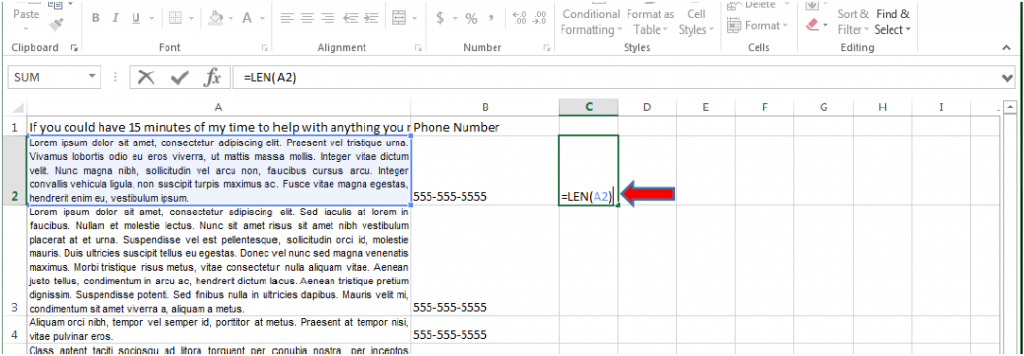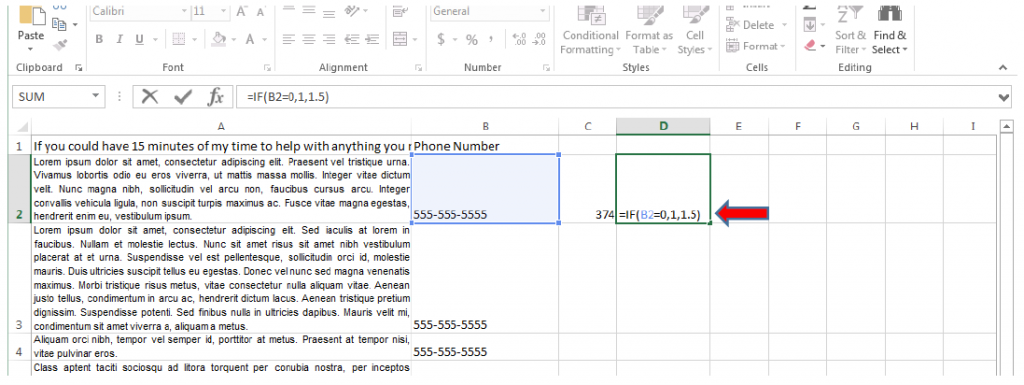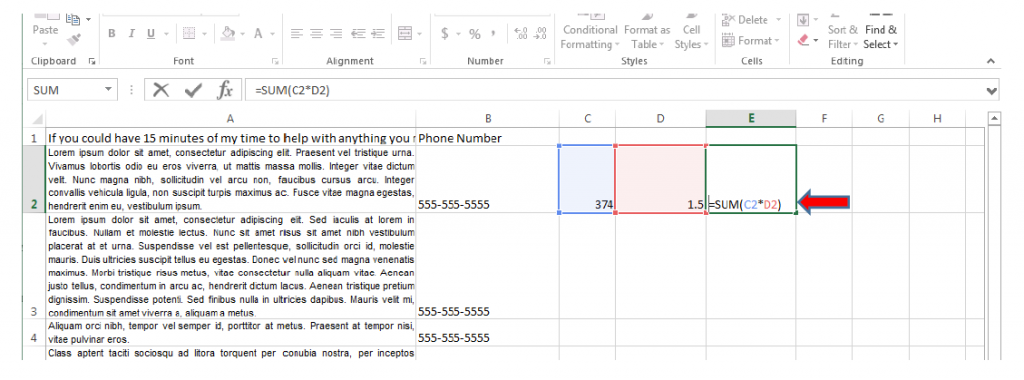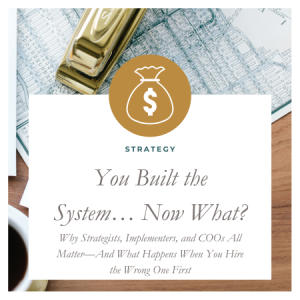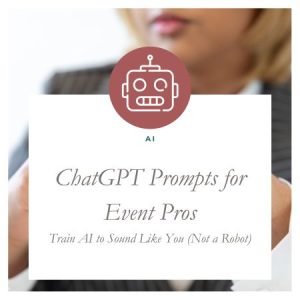
By now you’ve probably heard of the “Ideal Client.” That mythical creature that loves everything about you, your work and your business. She has money falling out of her pockets and her only desire is to ply you with cash and complements for the amazing work that you do.
Sound to good to be true?
Maybe it is.
You’ve likely spent at least a little time exploring your ideal client. You’ve fooled around with writing a description of her. You made sure to identify her wants, needs, desires and preferences. You’ve even started reworking your website, brand and social media to attract and accommodate her. In short, you’re doing everything you can think of to attract your ideal client, but something isn’t lining up.
Where is she?
The problem is, when you did your ideal client exercise, you likely described some version of yourself. Tell me where I’m wrong, but I’m guessing that you created your exact soul mate with money falling out of her pockets.
This is actually a terrific start. But it’s not enough.
The next step is to validate that your ideal client actually exists the way you imagine her. This will take real market research.
Here are five steps to help you truly attract an ideal client that really exists.
Step 1: Go deeper
You are a complex human being. So Is your client. The more you acknowledge this little fact, the better you’ll be at attracting a real ideal client.
Think about it for a moment. Close your eyes and bring to mind all the things in your life that you love that are outside of your role as business owner. Now note of all the backstory items in your business that you dream of or that keep you up at night. You may be thinking of that new, state-of-the-art oven or long lens that you want to buy. You may be worried about taxes or rent during the slow season. Your clients probably won’t know about these details but they all factor in, no matter how subtly, to your client relationships.
Your ideal client is the same. She has a life and desires beyond you and beyond her wedding. She may value her time on her horse or on the ski slopes. She may read Vogue and Dwell magazines for inspiration rather than wedding blogs and mags. She may be feeling tremendous pressure to manage her parents wishes for her wedding.
The point is, there’s always back story that you’ll want to at least understand when it comes to your ideal client.
And it’s the backstory that will allow you to really start attracting your ideal client.
You want to fully exploring her deepest wishes, fears and imaginings. You want to know all about the things that she does and enjoys outside of her wedding planning. You’ll want to connect with her and send the message: ” I know you and I totally get you.”
Go beyond the basics of demographics and explore her habits, her relationships and her favorite things. This will help you connect on a human level.
I know a luxury wedding photographer who was obsessed with a high-profile child murder case in Florida. She posted about it every time new details about the case emerged. Guess who her ideal client was. That’s right, lawyers. She was able to attract and connect with her ideal client based on shared interests beyond your basic block-and-tackle wedding planning information.
Think of your ideal client’s favorite books, what she loves to do in her spare time, and her guilty pleasures. What is her family like? What is her relationship to her friends? Then go into an emotional map of her wedding day and her wedding planning process. What is her dream wedding like? Not just where you fit in, but the whole wedding. What are her top three priorities? What does she secretly fear about her wedding? How do her friends and family feel about it? Go deep.
Need help? I have created a 16 page Ideal Client Avatar workbook with 39 questions that is a bonus to the Fast Start Guide to Market Research eBook. Both will help you go deep into the psychology and emotional makeup of your ideal client and find ways to truly attract her and compete for her attention in a crowded market. You will get your Ideal Client workbook within a few days of signing up.
The best part is you can use this information to write your web copy, blog or social media posts.
Step 2: Listen
At this point, you’re making a lot of assumptions about your ideal client. Right now, if we’re being honest with each other, your ideal client is a figment of your imagination.
Here’s where most wedding pros go wrong. They stop here, with their imaginings and assumptions.
Sometimes it works. Sometimes it doesn’t. It’s really a crap shoot unless you test and validate your assumptions.
To do this, look for your ideal client “in the wild.” Find her natural environment. This is where she hangs out when she thinks you’re not looking, and it’s where she truly expresses her desires and fears about herself, her relationships and her wedding.
Look on social media, discussion forums like the Wedding Bee, book reviews and (sometimes) comments on blogs. Don’t forget that your email conversations with potential clients are also a goldmine of information. When mining your inbox, focus on the clients you’ve loved working with. You don’t want to keep attracting the PITA (Pain In The Ass) clients.
Look for preferences you can relate to and problems you can help solve.
Start recording all of this in a spreadsheet. Be sure to record the exact words she uses. In fact, copy and paste the entire comment into your spreadsheet. You will use it later to determine it’s relevance. Also record where you found the information and be sure to capture the exact URL.
Step 3: Ask
If you have a client base, think of your top clients. Those amazing couples who lit you up and made you feel like you were doing your best work. Think of the clients you really connected with. Now survey them.
You’ll want to create a simple 2-question survey. This open-ended style is exceptionally good at identifying your ideal client’s most pressing problem in their own words.
The problem with most surveys is they are multiple choice and you, the survey designer are doing all of the choosing. Each choice becomes an assumption that you make about what you think is most important. By creating a simple survey with an open-ended question you will quickly get to the very heart and soul of your ideal clients.
For New Clients
- If you could have 15 minutes of my time to help you with anything related to your wedding, what would you ask me?
- If I promise not to sell you anything, can I follow up with a phone call? If so, please give me your phone number.
For Previous Clients
- What was the biggest challenge you faced when it came to when it came to [insert your industry here](planning your wedding, choosing your photographer, deciding on your wedding cake, stationery, DJ etc)?
- If I promise not to sell you anything, can I follow up with a phone call? If so, please give me your phone number.
The first question helps you get into your ideal clients head. The second question will be an indicator of how serious they are about solving their problem and how much they trust you to help them solve it. No one will leave a phone number if they aren’t serious about solving their particular problem.
Step 4: Record and Analyze What Your Clients Are Telling You
As you are listening online and surveying you clients. Record their exact words. in an excel spreadsheet. Set it up like this:
First set up your columns and get your data into your cells:
Column A should have your ideal clients’ exact language, either from your research “in the wild” or from your survey. Do not edit or delete anything. Take her entire comment and copy it in to Column A.
Column B should have her phone number (if provided). Column C should have her name. Column D should have the source of the comment. Column E should have the exact Website URL where you found the comment (if found in the wild).
Then code your document with relevant keywords.
Once you have 75-150 responses from your survey and comments from “the wild,” it’s time to start categorizing them into broader categories.
When you analyze your results, you’ll be looking for two things: richness and uniformity. Read through each comment and try and identify the broader category it fits into. It could be time, price, overwhelm, managing family expectations, etc.
Type a separate keyword for each column. Record up to three,
This will show you the most common themes in responses. Don’t eyeball this. You are trying to eliminate assumptions and biases. Use the actual data to guide you.
Now sort by richness of response.
Now you’re going to sort your data by the longest responses. The people who took took the time to write long responses are really feeling the pain of their situation. They are the ones most ready to get their problem solved or get their highest wishes for their wedding day.
And you are going to be the one there to help them.
First, select all of your data and copy it into a new tab. (You want to have a copy of your original work should anything happen.)
In your new tab, get rid of your columns with the Name, source and URL. You don’t need these right now.
Make sure your phone number column is in Column B. Keep your categories, but add three new columns in between the phone number column and the categories. Here’s and example from my own research for Mountainside Media:
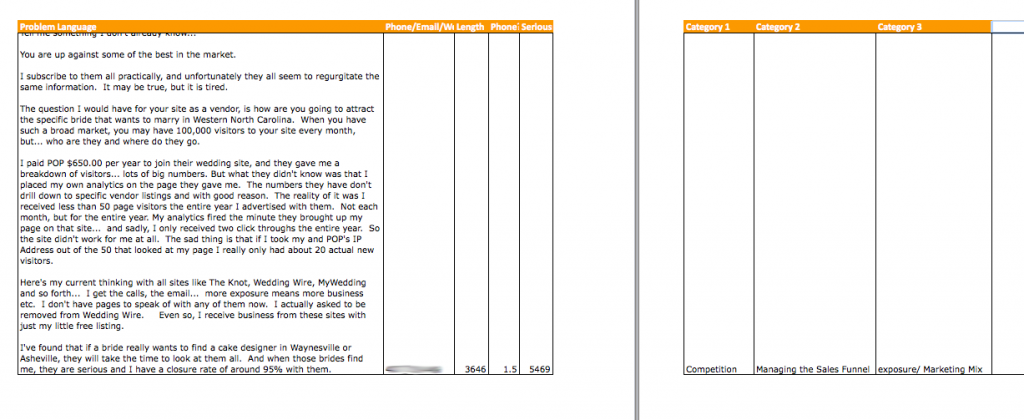
Now, in Column C, type in the formula =LEN(A2) across from the first response. This will tell you how many characters are in the response.
In Column D type in =IF(B2=0,1,1.5) This will calculate if there is a phone number and give it more weight if there is.
Finally in Column E enter the formula =SUM(C2*D2) which will calculate the serious of the response based on the length and if a phone number was given.
Now highlight the cells of the first response in Columns C, D and E. There is a green square on the bottom right. Mouse over it until you see it turn to a black + Click and hold while dragging it down to the bottom of your sheet. This will copy the formulas for other responses.
Select all of your data (excluding the header info.) Click on the Data tab and choose Sort. You’ll want to sort by Column H from largest to Smallest. This will float your “most serious responses to the top.

Finally, examine the top 25-30 responses. Look for uniformity in broad categories and the exact language your clients are using to describe their problem.
Now you not only know how to give them what they want, you also know what words to use to attract them.
Step 5: Learn and Tweak
At this point you’ll find that your original ideal clients was very close to the mark. You will also likely find that some of the language your real ideal clients use and some of their priorities differ from your original assumptions. Here’s where you need to start tweaking your ideal bride so she fits a real-world market while still inspiring you to do your best work. This is both art and science.
As you are learning and tweaking, be sure to use data to identify her real problems and desires. Find the intersection between what she wants and what you want to do with your business and focus on that.
Use her exact words. The lesson I learned in my own research was that I assumed that the “Ideal Client” concept was marketing jargon that wouldn’t make sense to my ideal vendors. Originally I was going to talk about “market personas” and “marketing plans” until I conducted my own research and found many rich comments about developing and using an Ideal Client Avatar to book more clients.
Since this is an absolute passion of mine, you are now reading a blog post about how to develop and validate your ideal clients. Without my own research, I would still be guessing and perhaps writing the wrong content.
Finally, each time you encounter an ideal clients, whether it’s “in the wild” or during a consultation, listen closely to the exact words she uses. Take exact notes during consultations and copy and paste entire comments that you find.
Keep a running record of these in an excel spreadsheet. At first, code and tweak once a month or so to ensure you’re on the right path. Eventually you can taper off to once or twice a year until you find that you are routinely attracting your ideal client.

